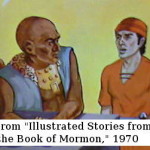Related Posts: Blacks and the Priesthood; Race issues in the Book of Mormon: Part I; Was Mormonism ever pro-slavery? Continued from Racism in the Book of Mormon: Part I Criticisms Interpreting the physical differences between Nephites and Lamanites as due to sun exposure is a recent development. In the recent past Mormons saw the difference … Continue reading “Racism in the Book of Mormon: Part II”
Related Posts: Blacks and the Priesthood; Race issues in the Book of Mormon: Part I; Was Mormonism ever pro-slavery?
Continued from Racism in the Book of Mormon: Part I
Criticisms
Interpreting the physical differences between Nephites and Lamanites as due to sun exposure is a recent development. In the recent past Mormons saw the difference in racial terms, visualizing the Lamanites as looking like Native Americans and the Nephites as Caucasian looking. So, a ccording to that view the Native Americans still carry with them the mark of the curse, and the Native American way of life–once so detested among white Americans–is evidence they had not given up their wild ways. Apostle Joseph Fielding Smith (d. 1972) wrote in Answers to Gospel Questions: “
ccording to that view the Native Americans still carry with them the mark of the curse, and the Native American way of life–once so detested among white Americans–is evidence they had not given up their wild ways. Apostle Joseph Fielding Smith (d. 1972) wrote in Answers to Gospel Questions: “
The dark skin of those [Indians] who have come into the Church is no longer to be considered a sign of the curse. Many of these converts are delightsome and have the Spirit of the Lord. Perhaps there are some Lamanites today who are losing the dark pigment. Many of the members of the Church among the Catawba Indians of the South could readily pass as of the white race; also in other parts of the South (p. 124; published 1957-1966).
Also, LDS art in the recent past tended to depict the Nephites as very European looking. More recent art tends to downplay the difference, but the Nephites are still depicted as being lighter complected than the Lamanites. (See here for some art samples from lds.org.) Continue reading “Racism in the Book of Mormon: Part II”
